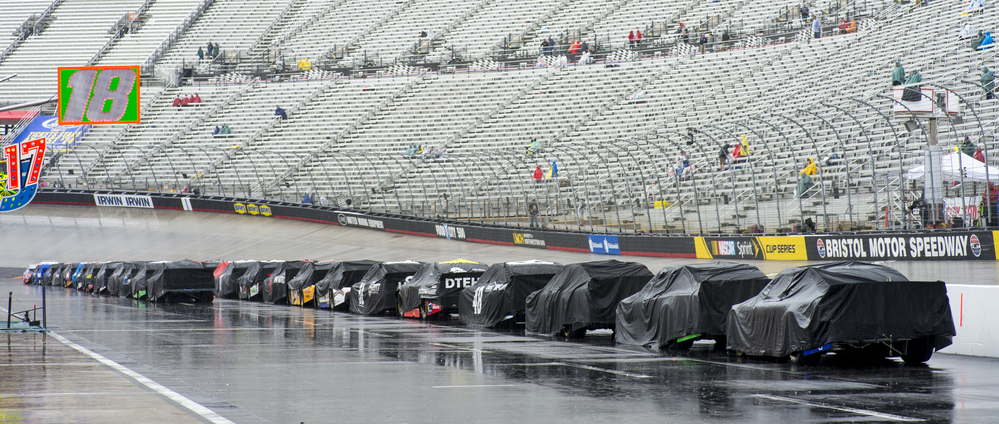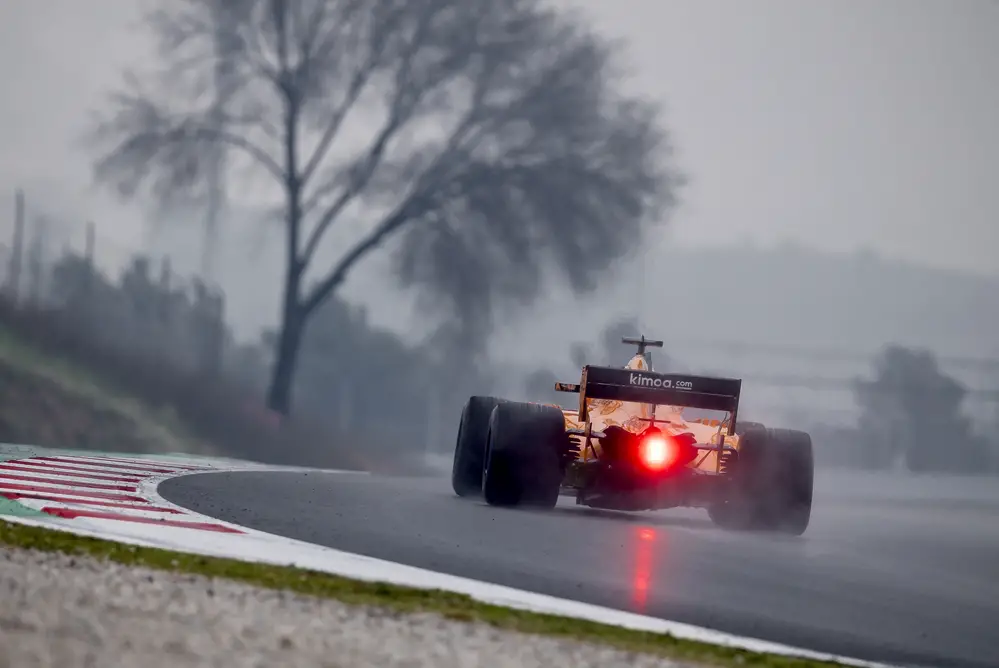NASCAR is undeniably a popular and thrilling motorsport, with millions of fans watching drivers push their limits on the racetrack.
One peculiar aspect of the sport, however, is that races are halted or postponed when rain starts to fall.
Quick Answer:
NASCAR traditionally doesn’t race in the rain due to safety concerns. The high speeds, slick tires, and heavy weight of NASCAR vehicles can make wet conditions extremely dangerous. Hydroplaning, poor visibility, and decreased braking effectiveness are significant risks. However, NASCAR has started to allow rain races on road courses using rain tires but still avoids rain conditions on oval tracks for safety.
The conditions in a wet race, such as reduced visibility, minimized grip, and hydroplaning, increase the possibility of accidents and compromise the safety of the drivers.
NASCAR And Weather Conditions
Race Start And Continuation
NASCAR races typically do not start or continue in the rain due to the nature of the sport. Racing in wet conditions poses a significant safety risk for drivers, teams, and fans.
The tires used in NASCAR are not designed to handle wet or slippery surfaces, which makes it difficult for drivers to maintain traction during rainy weather. Furthermore, visibility decreases in the rain, making it harder for the racers to see each other on the track.
The Red Flag Rule
The Red Flag Rule is a procedure implemented by NASCAR officials to temporarily halt a race in the event of adverse weather conditions. When rain begins to fall, officials may issue a red flag, which signals drivers to return to the pits and cease racing.
Once the race is red-flagged, teams will cover their cars and wait for the weather to improve. If the officials deem the track unsafe to race on due to standing water or other hazards, they may decide to postpone or reschedule the event.
Postponement and Rescheduling
In cases where rain and weather conditions are too severe to continue racing, NASCAR races may be postponed or rescheduled to a later date. This decision is made with the safety of the participants and spectators in mind.
To reschedule a race, NASCAR officials usually explore alternative dates and communicate the changes to everyone involved, including the Cup Series teams, track operators, and broadcast partners. Ultimately, the goal is to ensure a safe and competitive racing environment for all.
Why Rain Racing is Dangerous
Decreased Visibility
Rainy conditions can significantly reduce visibility on the track. This makes it difficult for drivers to see their surroundings and anticipate potential hazards. Heavy rain combined with the spray from other cars can lead to near-blind conditions, increasing the likelihood of accidents.
Additionally, wet weather may cause windshield fogging, requiring constant defogging to maintain a clear view.
Loss of Traction
Wet conditions decrease the grip between a car’s tires and the track surface. This loss of traction can cause the tires to slip or skid, making it harder for drivers to control their vehicles and maintain proper racing lines. As a result, cars may spin out or collide with one another, leading to crashes.
Tires designed for dry conditions do not perform well in wet weather, as they cannot channel water away effectively, further reducing grip levels.
Hydroplaning
Hydroplaning is a dangerous phenomenon that occurs when a layer of water builds up between the tires and the track surface. This can cause a loss of contact with the ground, reducing the car’s ability to accelerate, steer, or brake.
Hydroplaning can occur even at relatively low speeds, and the risk increases with the intensity of the rain. When hydroplaning, drivers have limited control over their vehicles, which can result in accidents or off-track excursions.
The Role of Rain Tires
Racing in the Rain with Rain Tires
Rain tires play a crucial role in motorsports when it comes to racing in wet conditions. Unlike regular racing tires, rain tires are specifically designed to handle the challenging conditions brought on by rain.
They help provide the necessary grip on wet surfaces, ensuring drivers can maintain control over their vehicles while navigating slippery tracks.
Tread Patterns
A critical feature of rain tires is their distinct tread patterns. While standard racing tires are smooth, rain tires have grooves and channels designed to improve traction and disperse water effectively.
This allows for a better grip on the track, reducing the chances of hydroplaning.
Some common rain tire tread patterns include:
- Directional treads: These patterns feature V-shaped grooves that help channel water away from the contact patch, improving grip on wet surfaces.
- Asymmetrical treads: These designs combine grooves and blocks to optimize both wet and dry performance, offering a balance between grip and longevity.
Wear and Performance
When it comes to wear and performance, rain tires differ from their dry counterparts. Since they are designed specifically for wet conditions, they are made from softer rubber compounds to provide better traction. This characteristic also makes them wear out faster than regular racing tires when used in dry conditions.
To ensure optimal performance, teams will often monitor the tire temperatures and wear rates and decide when to switch to rain tires or back to standard racing tires based on the track conditions.
This strategic decision can significantly influence the outcome of a race, making the role of rain tires all the more important in motorsports.
The Impact On NASCAR Teams And Drivers
When rain affects NASCAR races, the decision to continue or postpone the race is crucial to ensure the safety of the drivers and teams. Delaying the race can cause scheduling conflicts for teams and drivers who participate in the multiple series that NASCAR offers, such as the Cup Series and Xfinity Series.
For instance, a driver like Kyle Busch, who often races in both the NASCAR Cup Series and Xfinity Series, could potentially face a dilemma when an Xfinity Series race is affected by rain.
This could lead to situations where a driver like Busch or others, like Kevin Harvick, Chase Elliott, or Cole Custer, may need to make a decision on whether to prioritize one race over another.
In addition, racing on wet tracks significantly impacts the speed and performance of the cars. This is especially evident in iconic races such as the Daytona 500, where NASCAR is known for its high speeds and close racing.
Inclement weather conditions force drivers to lower their speeds and adopt a more cautious driving style to maintain control of their vehicles and avoid accidents.
Furthermore, NASCAR races, particularly in the Cup Series, require a great deal of strategic planning and coordination between drivers and their teams. A shift in the weather can disrupt the elaborate strategies put in place, causing teams to make crucial adjustments on the fly.
As a result, teams and drivers must be well-versed in adapting to changing conditions, as an ineffective adaptation can lead to a loss of efficiency and potential accidents.
Other Racing Series and Rain
Formula 1 Rain Racing
In Formula 1, racing in wet conditions is quite common, and the series has specially designed tires to handle it. These tires have grooved surfaces that help disperse water, allowing the cars to maintain traction on slippery tracks.
Drivers in Formula 1 need to have excellent skills and instincts to navigate rain-soaked courses successfully, as these conditions can change rapidly during a race.
Road Courses versus Oval Tracks
Road courses and oval tracks present different challenges when it comes to racing in the rain. Road courses, like the Circuit of the Americas, are designed with a variety of turns – not just left turns like in oval racing.
This layout provides more opportunities for water to drain off the track, making it easier to race in wet conditions. Additionally, since road courses are not as confined as ovals, it’s possible for drivers to adjust their lines and avoid puddles or standing water.
On the other hand, oval tracks are predominantly used in NASCAR. These tracks are characterized by high-speed, continuous left turns, which can amplify the effects of rain.
The banking of oval tracks can lead to water pooling, creating dangerous hydroplaning conditions for cars traveling at over 200 miles per hour. NASCAR prioritizes driver safety, so their rules dictate that oval races be stopped or postponed in case of rain to avoid any accidents or risk.
Safety Measures And Precautions
NASCAR prioritizes the safety of the drivers and other individuals on the track when making decisions about whether to race in inclement weather conditions like rain. Several factors contribute to the challenges and potential hazards of driving in the rain, making it necessary to implement safety measures and precautions.
One significant concern with racing in the rain is the possibility of standing water on the track. Vehicles traveling at high speeds can cause a phenomenon known as “hydroplaning,” where the tires lose contact with the road surface due to a layer of water, leading to loss of control and potential accidents.
To prevent hydroplaning and maintain a secure racing environment, NASCAR officials monitor track conditions and deploy the caution flag if there’s excessive water on the surface, signaling drivers to slow down or stop.
An additional element of concern during rainy conditions is the presence of lightning in the area. Lightning poses a severe threat to the safety of the drivers, crew members, officials, and spectators alike.
NASCAR officials are vigilant in monitoring weather conditions and will suspend racing activities if lightning is detected within a certain radius of the track.
To improve visibility during wet weather, NASCAR vehicles are equipped with windshield wipers. Although these wipers can clear the windshield enough for drivers to have a reasonable view of the track, they may still experience limited visibility due to heavy rain, rooster tails of water, or mist created by other vehicles.
This reduced visibility is a significant concern for driver safety, as it may lead to accidents if drivers cannot see other cars or upcoming obstacles.
Driving in the rain can also be challenging due to the slippery track surface, which affects the tires’ grip and overall vehicle control. NASCAR vehicles are specifically designed and optimized to perform on dry tracks, and adapting these vehicles for wet conditions would require changes in tire selection and car setup.
While rain tires are available and have been used in some instances, they are not as effective as dry tires, and therefore their use in predominantly dry conditions can compromise driver safety.
Race Delays and Impact on Fans
Shortened or Delayed Races
Wet tracks can cause multi-car accidents that endanger drivers and have a profound impact on race outcomes. For example, at the Martinsville Speedway, sudden showers have caused incidents that resulted in the rescheduling of races.
Rain delays can be frustrating for fans who have traveled long distances to attend a race. These delays can lead to longer wait times, leaving spectators to find alternative forms of entertainment until the race resumes.
Outdoor Events
NASCAR events often include outdoor activities and performances. During race weekends or rain-delayed events, fans can enjoy performances by artists like Charley Crockett, Miranda Lambert, and other popular acts in the Chicago area.
However, when rain interferes with these outdoor performances, it may lead to cancellations or rescheduling, leaving fans disappointed and compromising the overall event experience.
Conclusion
In summary, NASCAR races are not held in the rain primarily due to safety concerns.
The combination of high speeds, limited visibility, and wet track conditions increases the risk of accidents. Additionally, NASCAR vehicles are specifically designed for dry track conditions, with slick tires and aerodynamics that wane during wet weather.
While some racing series, such as Formula 1, have adapted to wet conditions with specialized tires and vehicle modifications, NASCAR has maintained its tradition of racing exclusively in dry conditions.


